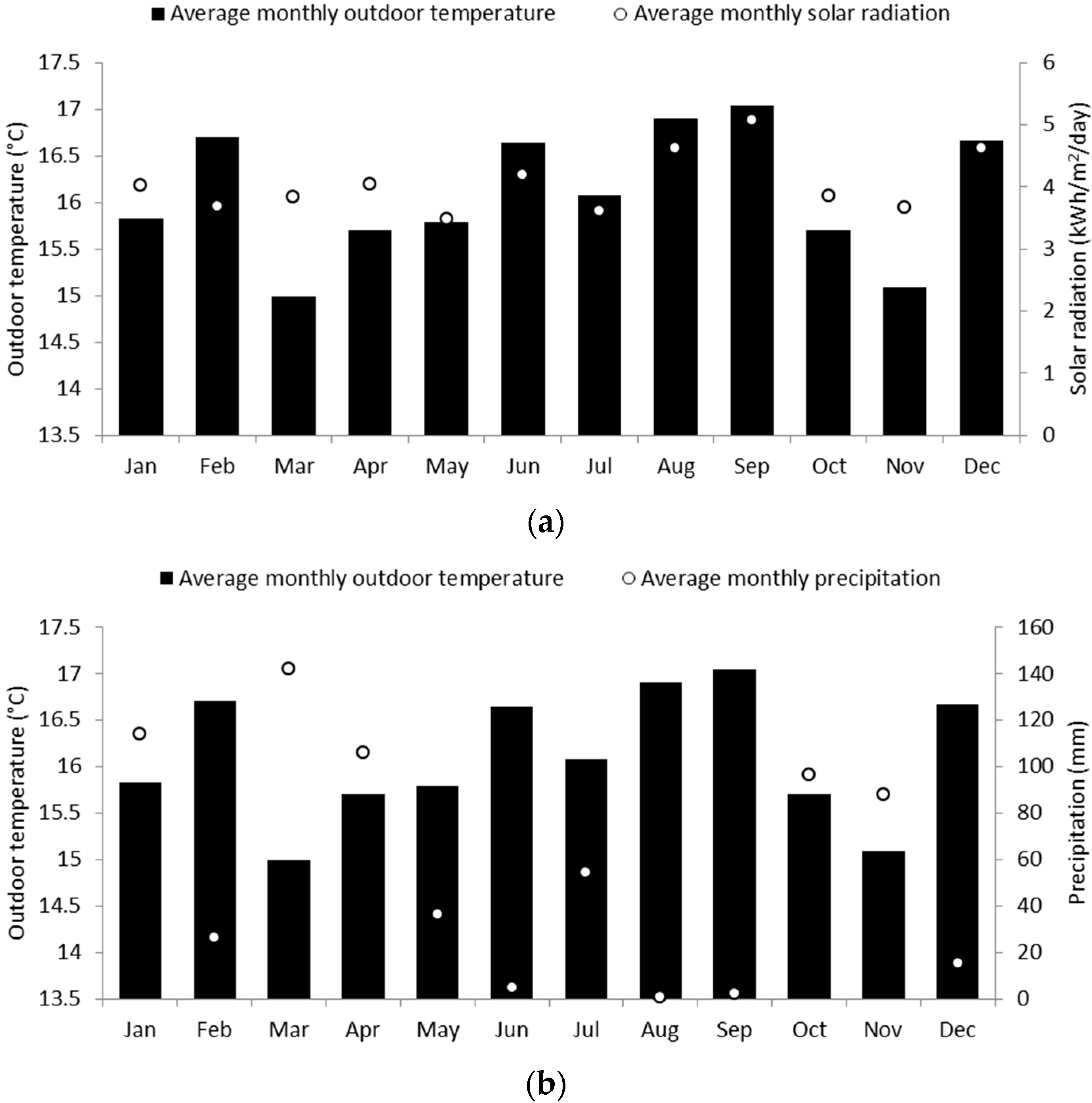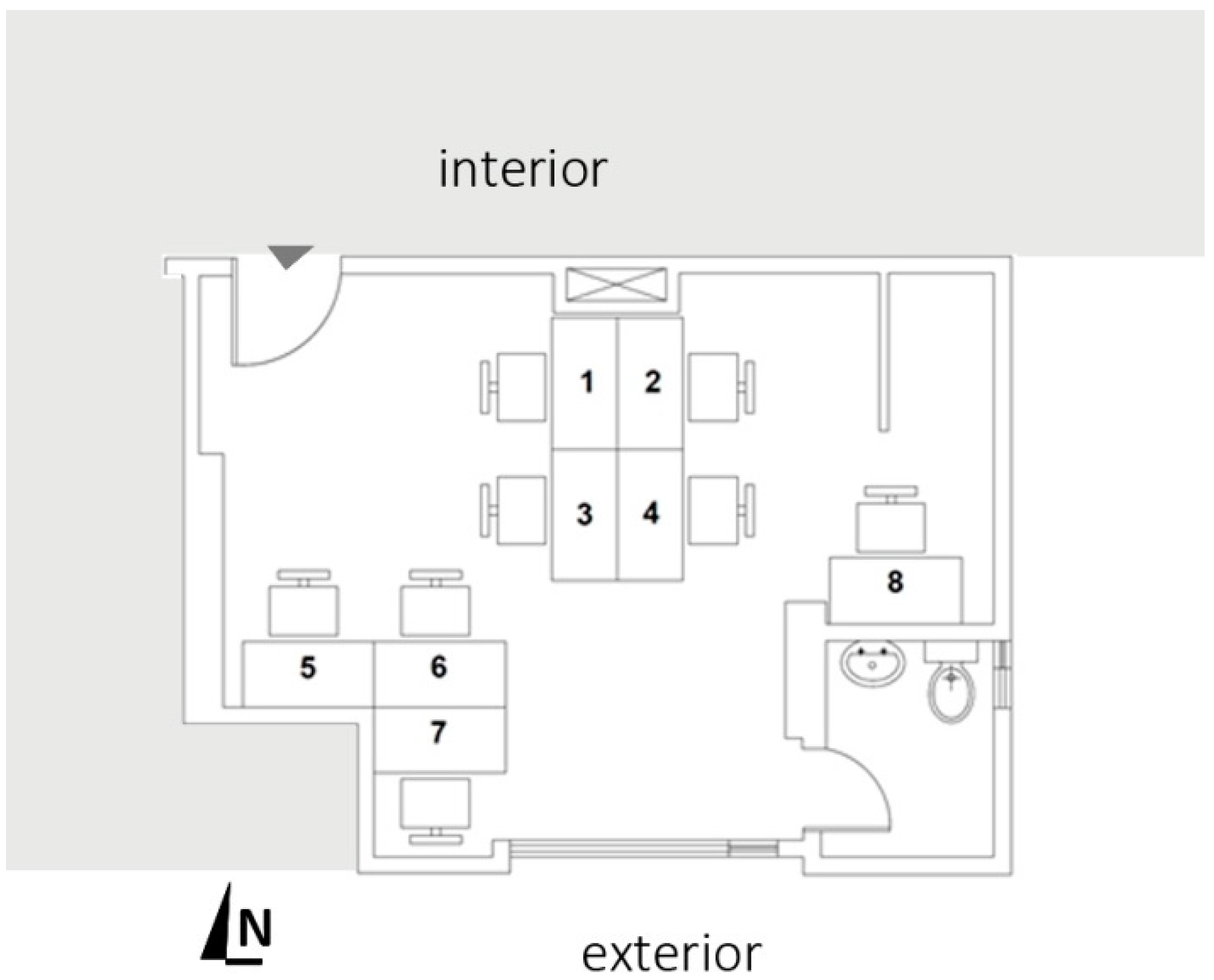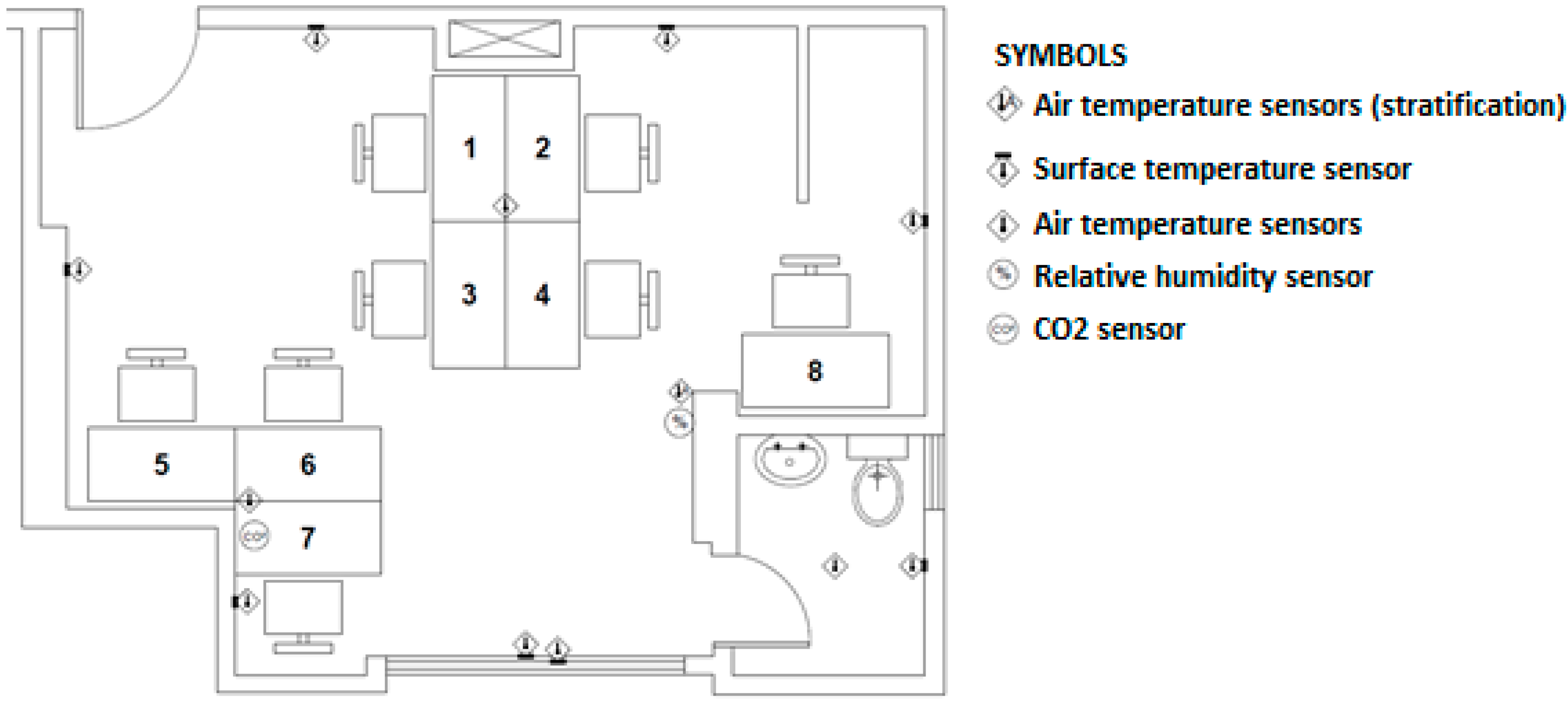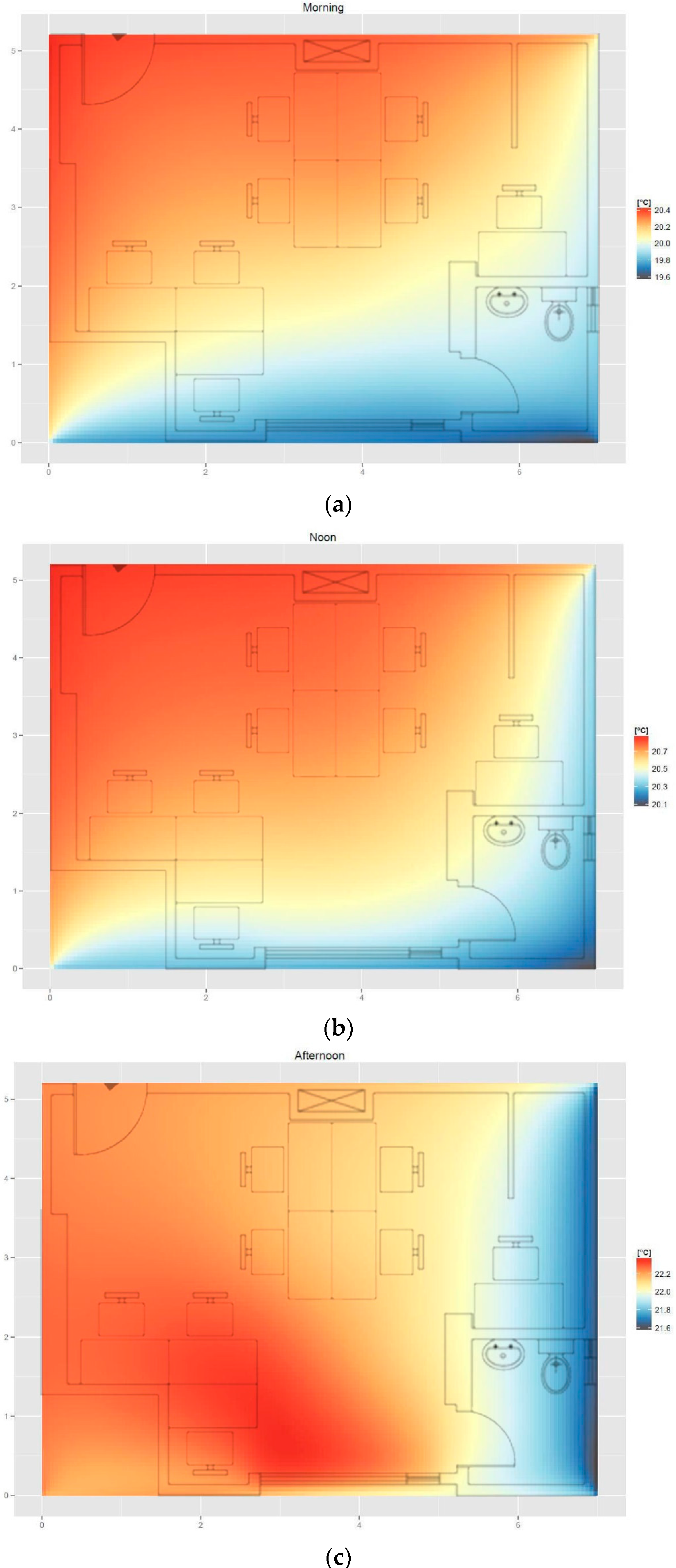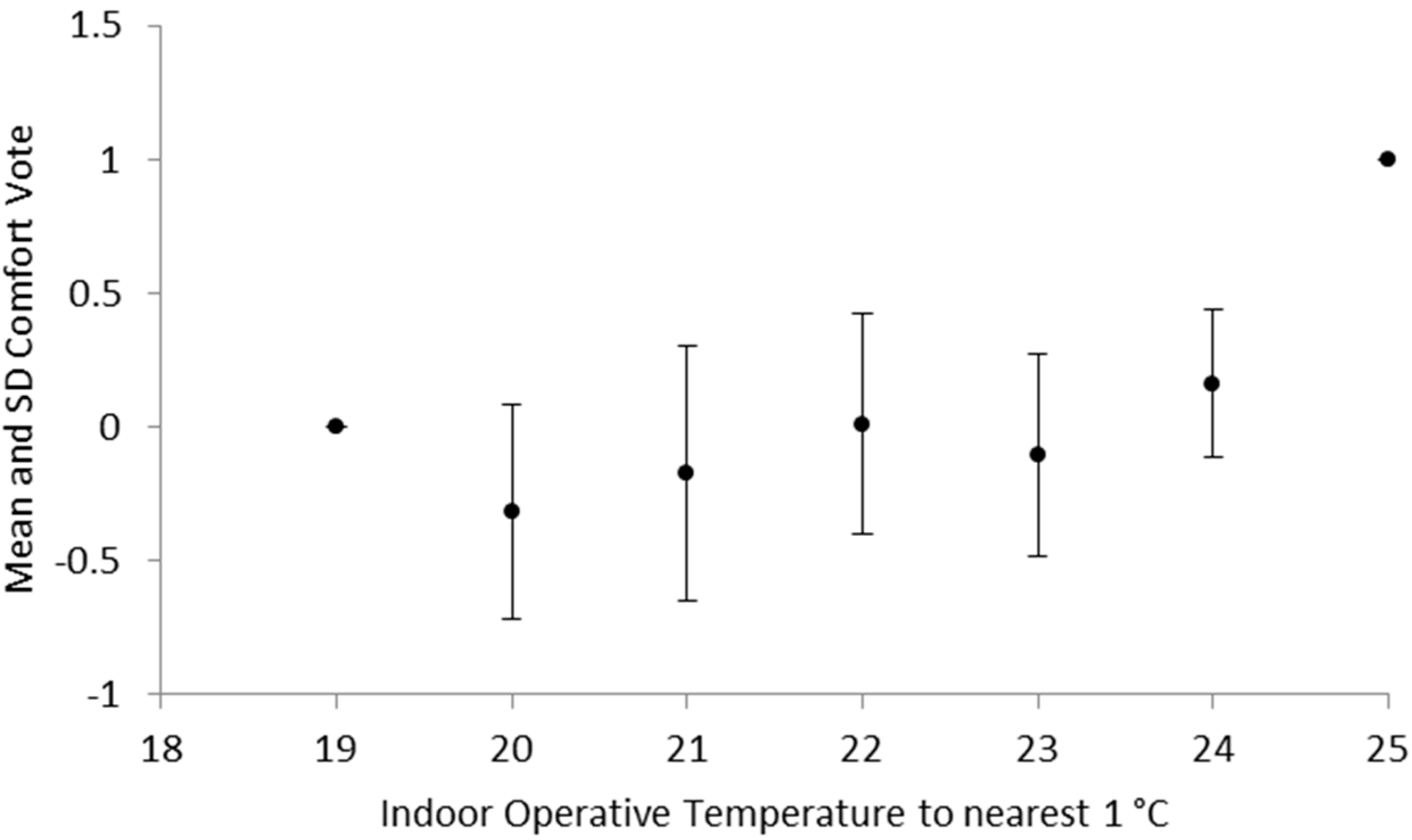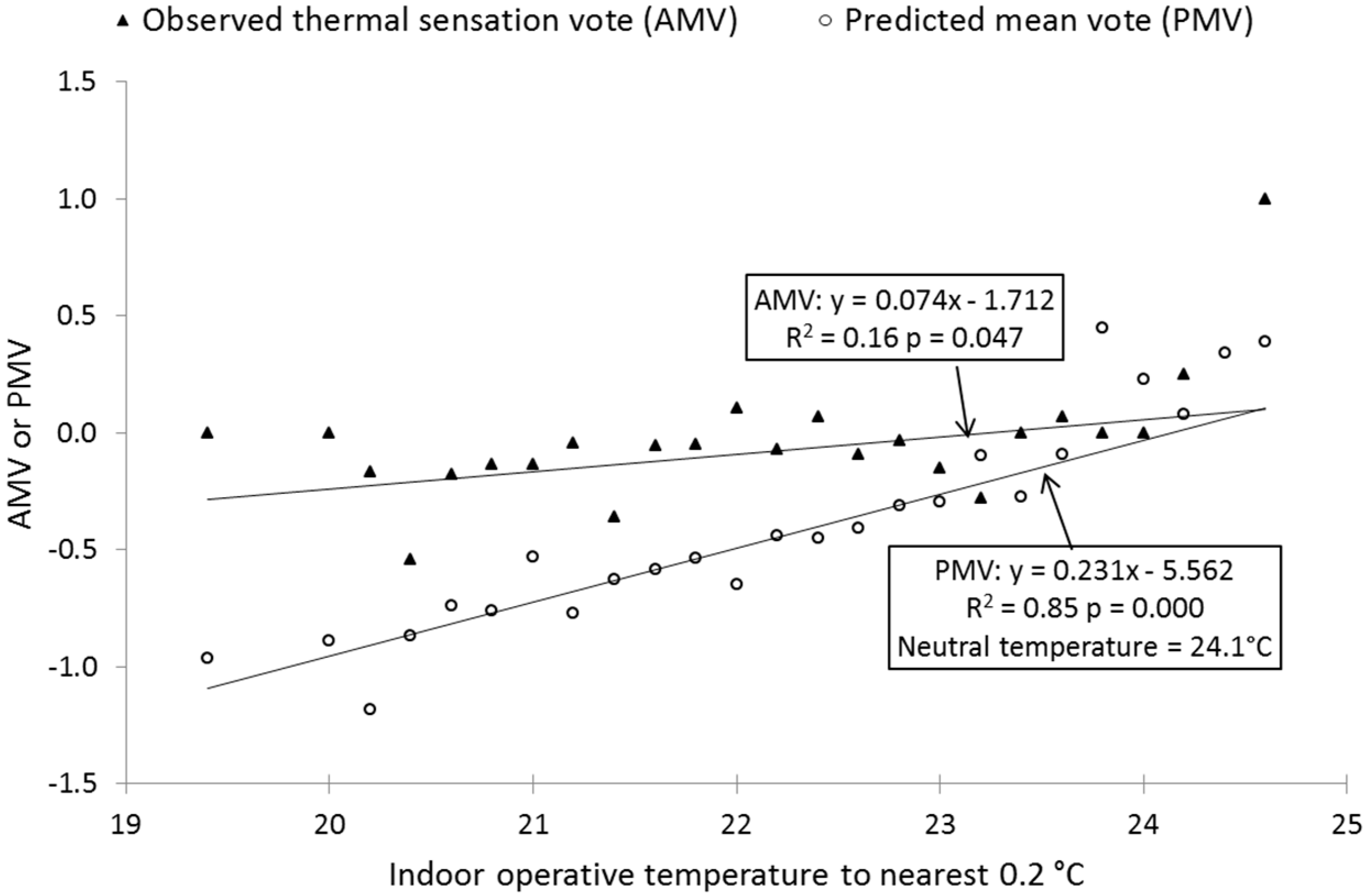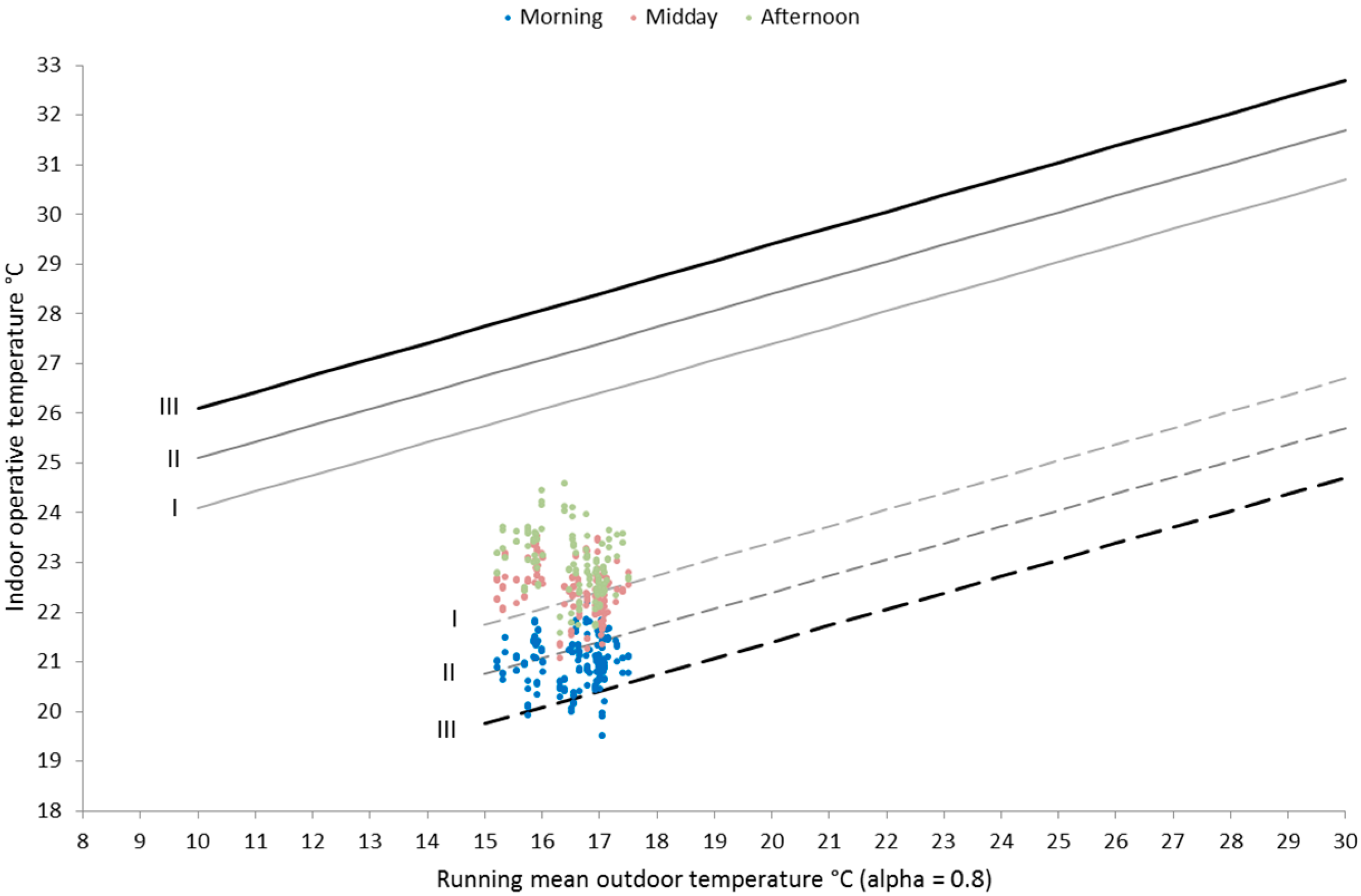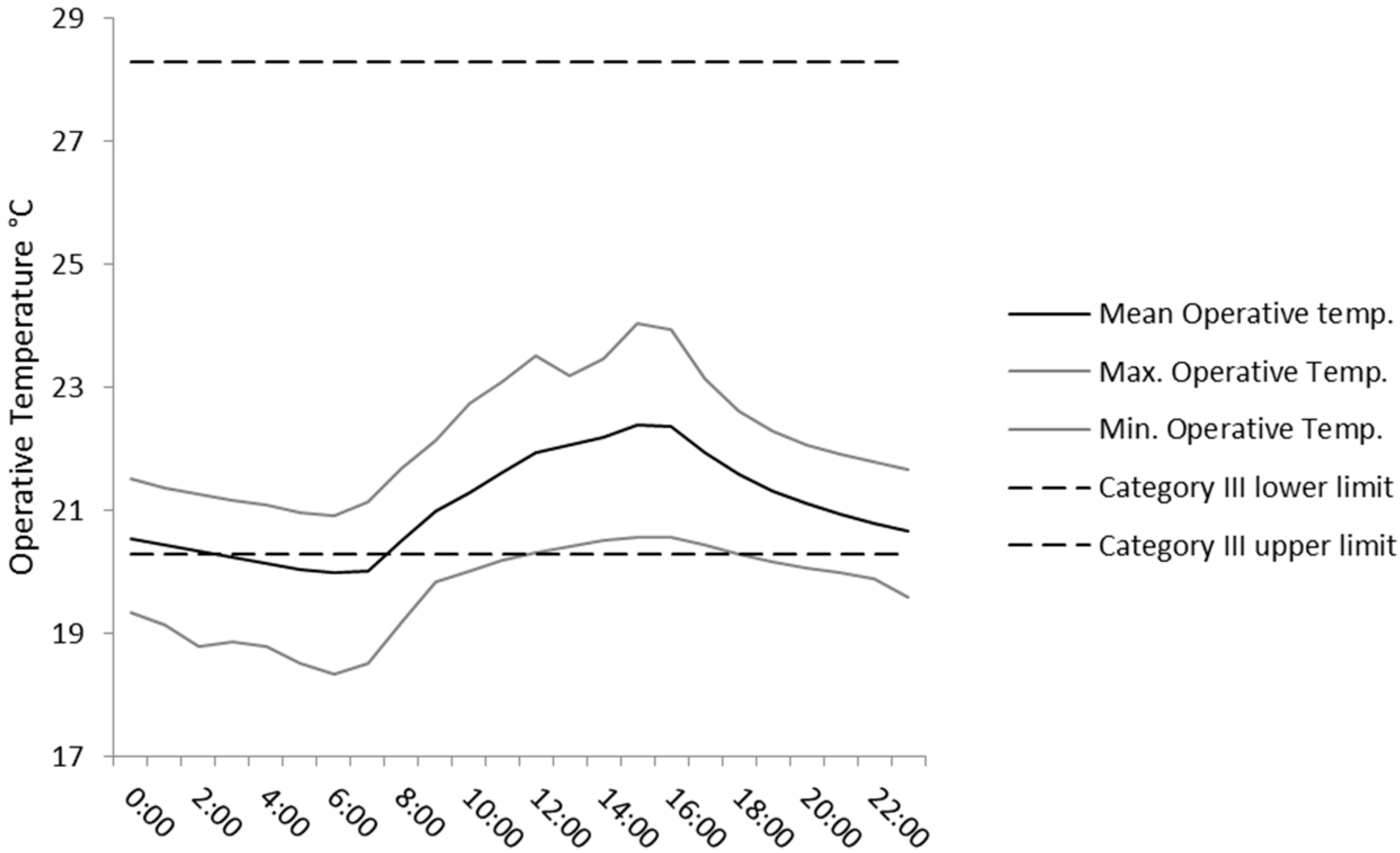1. Introduction
The main function of a building is to provide and maintain a comfortable indoor environment with the lowest energy consumption. In order to ensure the thermal comfort of the occupants of a building, usually mechanical heating, ventilating and air conditioning (HVAC) systems are installed. However, in temperate climates, such as in Quito-Ecuador, the vast majority of buildings do not have such systems, so it is not possible to guarantee interior thermal neutrality conditions throughout the occupation period.
Several studies indicate that assuring adequate thermal comfort conditions inside buildings is essential not only for the health of the occupants, but also in terms of productivity and efficiency [
1,
2,
3]. However, comfort issues do not yet play a major role in the design stage and in the day-to-day operation of buildings in the construction sector in Ecuador, mostly due to a lack of knowledge and understanding of human thermal comfort and the related in situ assessment and a lack of thermal comfort standards applicable to the buildings in the country.
On the other hand, the scientific community has been developing studies and accumulating knowledge on comfort in indoor environments for decades, since the seminal study “Thermal Comfort” of Fanger [
4]. The results and the most important findings are now the basis of the main international standards related to the interior thermal environment, such as ISO 7730 (2005) [
5], ASHRAE 55 (2010) [
6], and CEN Standard EN15251 (2007) [
7]. The most widely used thermal comfort index in these standards is obtained by the PMV equation (Predicted Mean Vote) proposed by Fanger [
4], which predicts the thermal perception of the occupants of an indoor environment according to the seven point thermal sensation scale proposed by ASHRAE.
Although models based on the PMV as an index of thermal comfort are the most commonly used and accepted worldwide, several field studies indicate that these models are not accurate for predicting the thermal sensation of occupants of buildings with natural ventilation, and they tend to underestimate or overestimate the actual conditions of comfort [
8,
9,
10,
11,
12,
13]. Many researchers consider that this mainly happens because the PMV model was developed based on studies conducted in climatic chambers (laboratory conditions) where the indoor operative temperatures are generally stable, unlike what happens in naturally ventilated buildings where the operative temperatures are generally variable. For this reason, new adaptive thermal comfort models and modifications to the traditional PMV model have been developed in recent years to evaluate the internal thermal environment or to improve the accuracy of prediction of human thermal sensation in naturally conditioned buildings. The most widely used models are the adaptive models proposed by Dear and Brager [
14] and Nicol and Humphreys [
15], the modified PMV models proposed by Fanger and Toftum [
16] (PMV extended model), and Yao’s PMV adaptive model [
8].
The adaptive comfort model proposed by Nicol and Humphreys [
17] is based on experimental studies conducted in 26 European offices in France, Greece, Portugal, Sweden, and the UK. Studies showed that occupants in the naturally ventilated buildings accept, and actually prefer, a significantly wider range of temperatures compared to occupants of the HVAC buildings. In addition, it was noted that these comfortable indoor temperatures vary according to changes in the outside temperature and often fell outside of the ISO Standard 7730 comfort zones. The results of the adaptive model proposed by Nicol and Humphreys have been considered as the basis for a standard proposal applicable to naturally conditioned buildings, which is included in CEN Standard EN15251.
There is no information related to thermal comfort in buildings located in Ecuador, which is the reason why the authors decided to undertake a comfort research in this region, and observe the complexities of the comfort system they themselves inhabit. Because context, culture, buildings and climate are unique to any particular place, so also are the comfort needs and expectations of its inhabitants. A field study, such as the one performed in this research, can tell us a lot about the best way to design buildings that are appropriate to the climate and culture of people in this specific location of the world. By comparing the adaptive model included in CEN Standard EN15251 and the so-called static model (PMV model) with reports of thermal environment satisfaction surveys presented simultaneously to all occupants of the office, this study aims to determine which of the two comfort models is most suitable to evaluate the thermal environment of the office. Unlike other studies, the present work analyzes the interior thermal environment of the office in actual operating conditions and evaluates the thermal perception of each of its occupants simultaneously depending on their location within the office.
By applying the methodology for field studies proposed by the adaptive model, the authors seek to contribute to the worldwide effort, started by Humphreys and Nicol in the 1970s and continued around the world by Auliciems, de Dear, Brager, Baker, Oseland, and a growing band of researchers, in an attempt to map comfort conditions in every major climatic zone. We hope that local researchers will use the contents of this article to help them in the conduct and analysis of their own field surveys and that they will in their turn make their own findings available to others interested in the development of a better understanding of thermal comfort in buildings.
Thermal comfort research is a global endeavor, and many of the most important findings rest on the results of a large body of studies. The adaptive models developed by de Dear and Brager and Nicol and Humphreys were based on the results of many thermal comfort studies that are included in two different databases. From this point of view, the field study presented in this article is a valuable record of particular people, in a particular building, in a particular climate. This work can add to a global database of results of thermal comfort studies, which is required to establish an adequate and accurate adaptive standard that applies to “naturally conditioned” buildings in every climatic zone.
2. Case Study and Methodology of Investigation
2.1. Climate in Quito
Under the Köppen climate classification, Quito has a subtropical highland climate (Cfb) [
18]. Because of its elevation (2850 meters above sea level) and its closeness to the equator, Quito has a fairly constant cool climate and receives some of the greatest solar radiation in the world (
Figure 1a). The annual average temperature in the year in which this field study was performed was 16.1 °C. As shown in
Figure 1b, the city has only two seasons: dry and wet. The dry season (June through September) is referred to as summer because it coincides with high temperatures; the wet season (October through May) is referred to as winter. The average daily outdoor temperature ranges from 12 to 19 °C.
2.2. Characteristics of the Selected Office
The field study is conducted in an office located in an urban area of Quito-Ecuador (latitude 0°13′ S, longitude 78°31′ W) in a temperate climatic zone. For this reason, the office and the majority of the buildings located in this city are naturally conditioned and ventilated, which means that there are no HVAC systems installed to ensure interior thermal comfort conditions. The occupants of the office employ adaptive mechanisms such as manual operation of windows, clothing changes and drinking hot drinks to maintain thermal comfort conditions.
The office has a surface area of 36.5 m
2, including bathroom area, a height of 2.3 m, and is located on the sixth floor of the building “Torres Bossano”. Natural ventilation is the main conditioning strategy inside the office, which is induced by manual operation of the only window in the office located in the south facing wall. There are seven researchers working in this office distributed in workstations without vertical divisions between them, as shown in
Figure 2. During the experimental study, workstation number 1 was unoccupied, so it was not considered.
Each workstation has a desk, a standard office chair, and a computer. Other equipment includes a coffee maker, a telephone, an electric heater, and a copier/printer. The lighting system includes four luminaries with three T8 fluorescent lamps of 17W each, and a compact fluorescent bulb. The schedule of occupation of the office is Monday to Friday from 08:00 to 16:30, including half an hour for lunch.
The office consists of four vertical opaque walls facing north (back wall where the entrance is located and overlooks the hallway of the sixth floor), south (front wall which includes the main office window, with a window-wall ratio of 35% and exposed to the outside), west (partition wall between offices), and east (wall exposed to the outside). The construction materials of the office are shown in
Table 1. It is noteworthy that the use of thermal insulation is unusual.
2.3. Experimental Campaign and Surveys
Thermal comfort theory suggests that the most important variables that influence human thermal comfort and that are considered in the calculation of the PMV index are: physical variables (air temperature, mean radiant temperature, air velocity, and relative humidity in the interior environment) and personal variables (activity levels and thermal resistance of clothing).
To experimentally evaluate the thermal comfort by the traditional PMV method and the adaptive model, interior physical variables were measured and calculated. In addition, the thermal resistance of clothing, the metabolic rate, and the actual thermal sensation of the occupants of the office were reported by means of survey questionnaires for comparison with the predicted thermal sensation using the PMV model.
2.3.1. Measured Physical Parameters
A monitoring system was installed inside the analyzed office to measure interior physical parameters such as: air temperature, surface temperatures of opaque walls and windows, and relative humidity. To measure air and surface temperatures, thermocouples type K were installed, as shown in
Figure 3. The measurements were carried out for the period of 17 August to 20 October 2015 because it is the period for which survey results are available. The measured physical parameters and accuracy of the instruments are presented in
Table 2.
The measuring points inside the office were selected primarily based on workstation positions. Three indoor air temperature sensors were placed at a height of 1.1 m from the floor, in accordance with the requirements of the standards ISO 7730 (2005) [
5] and ASHRAE 55 (2010) [
6]. To measure the surface temperature of the opaque walls and the main window of the office, sensors were placed at a height of approximately 1.5 m from the ground, or so that the sensor was placed at the center point of each surface. Only one relative humidity sensor was installed at a height of 1.5 m from the ground, considering that the surface area of the office is relatively small, so there will be no considerable variations in humidity on the inside. For all variables, measurements at one-minute intervals were taken 24 h a day.
Figure 3 shows the location of all sensors within the office, as well as the appropriate symbols to identify them.
Because the office is a closed room located in a temperate climate, air movement is very slight, particularly away from the walls. Such low air velocities were very difficult to measure. For this reason, air velocity was not recorded continuously, but it was calibrated several times during questionnaire session to ensure that the measured physical parameters were sufficient to calculate the PMV as a comparative index. By means of thermal environment satisfaction surveys, it was determined if the main office window was open or closed at the time when people filled out the survey. In this way, a relationship between the operation of the window and the air velocity was developed, and then, simply, we kept a record of the operation of the window to estimate the air velocity. The recorded air velocities when the window was open were always below 0.2 m/s. When the window was closed, air velocities below 0.1 m/s were recorded. Nicol, Humphreys and Roaf in their book “Adaptive thermal comfort: Principles and Practice” [
3] indicate that accurate measurement of air velocities below 0.1 m/s is unnecessary and could be misleading. For this reason, we established an air velocity of 0.2 m/s when the window was open, and an air velocity of 0.1 m/s when the window was closed.
Additionally, outside air temperature was measured at a weather station located near the office building. The outside air temperature was measured over the same period in which the experimental study was conducted in order to evaluate thermal comfort with the adaptive model proposed by Nicol and Humphreys [
3]. The weather station that was installed (Davis model Vantage Pro 2 Plus Wireless) has the advantage of a wireless connection to the data logger. The station has the following sensors of environmental monitoring: temperature and humidity sensors (thermo-hygrometer), anemometer with wind vane, pluviometer, solar radiation sensors, and ultraviolet radiation.
From the records of outside air temperature, the running mean outdoor temperatures were calculated using the equations (Equations (1) and (2)) included in CEN Standard EN 15251 (2007) [
7]:
where
is the running mean temperature for today,
is the running mean temperature for the previous day,
is the daily mean external temperature for the previous day,
is the daily mean external temperature for the day before and so on, and
is a constant between 0 and 1 (recommended to use 0.8) [
3].
2.3.2. Calculated Physical Parameters
The mean radiant temperature in each workstation of the office is obtained from measurements of surface temperatures and the angle factors calculated with the methodology proposed by Fanger [
4] and the equations included in the standard ISO 7726 [
19]. To simplify the calculation of angle factors, the office was considered as a single rectangular volume, and it is assumed that the occupants are sitting in their workstations. Considering that most building materials have high emittance ε, the mean radiant temperature is calculated using Equation (3):
where
is the mean radiant temperature,
is the Surface temperature of the Surface N, and
is the angle or view factor between a person and the surface N. The sum of all the angle factors is unity.
In addition, the operative temperature was calculated in each workstation position using Equation (4) according to ASHRAE 55 (2010) [
6].
where
is the operative temperature,
is the interior air temperature, and
is the mean radiant temperature. The value of
A can be found in Appendix C of ASHRAE (2010) as a function of the relative air speed.
From Equations (3) and (4), a spatial distribution of operative temperature inside the office was obtained. This allows analyzing and comparing the thermal sensation of each occupant, according to the operative temperature in their workstation position within the office. It is important to mention that the method to calculate mean radiant temperature has not considered other interior surfaces, such as table surfaces, the computer surfaces, etc.
2.3.3. Thermal Environment Surveys
To perform a subjective analysis of the internal thermal environment of the office, the use of occupant thermal environment surveys was considered. The survey questionnaire is an integration of the one proposed in the Informative Appendix E “thermal environment survey” of ASHRAE 55 (2010) [
6]. It includes basic information from respondents such as their clothing and activity levels, which allows estimating the values of clothing insulation and metabolic rates respectively. In addition, the ASHRAE seven-point scale of thermal sensation (−3 cold, −2 cool, −1 slightly cool, 0 neutral, +1 slightly warm, +2 warm, +3 hot) was included, so the occupants of the office could express their thermal sensation through the actual mean vote (AMV), which is compared to predicted thermal sensation using the PMV model.
In order to compare the values of AMV and PMV for the same conditions, the survey also included questions related to the day and the time in which the survey was answered (morning, midday, afternoon) and the workstation position of the respondent.
Finally, the questionnaire included a question related to the adaptive mechanisms used by occupants of the office to regulate internal thermal comfort conditions. This question was useful to obtain information of the window operation, and thus estimate the relative air speed inside the office. The web-based comfort questionnaires were sent directly to the personal computer of each participant. All subjects were quite familiar with the reply procedures, ensuring that their responses were consistent with their actual feelings. The thermal environment surveys were conducted from 17 August to 30 October 2015, from Monday to Friday. During this period, the occupants of the office, as far as possible, responded to the survey three times a day (morning, midday and afternoon). A total of 441 questionnaires were collected.
2.4. Evaluating Thermal Comfort
Based on the measured environmental parameters, the calculated mean radiant temperature, and the estimated values of relative air speed, metabolic rate and clothing insulation, the thermal comfort index PMV was calculated using the algorithm included in ISO 7730 (2005) [
5] and ASHRAE 55 (2010) [
6]. To determine the influence of both the window position and the position of each occupant within the office in its thermal sensation, the PMV index was calculated for each occupant in their respective workstation. The calculated PMV values are compared with the values of actual mean vote (AMV) reported in the thermal environment surveys and that indicate the actual thermal sensation of occupants.
As in other studies [
9,
10,
20,
21], a weighted linear regression between PMV and AMV and the operative temperature is performed. Considering that data was insufficient to produce a reliable regression estimate of the comfort temperature, the Griffiths’ method was used for assessing the mean comfort temperature. The comfort temperature was calculated from comfort votes by assuming that a comfort vote of neutral will represent an estimate of “comfort”. If the comfort vote C for neutral is
(the numerical value of C for neutrality) then the comfort temperature
can be calculated from the actual operative temperature
using the following relationship (Equation (5)) [
15]:
where
is the “Griffiths slope” (
. A study developed by Humphreys [
17] and other surveys found that the most likely value for the Griffiths’ slope is about 0.5
, so this value was used.
4. Discussion
Based on the results of the thermal environment surveys, buildings located in Quito-Ecuador may have, in general, an acceptable thermal environment. However, it is important to note that the indoor environment may require a heating system to maintain comfort conditions especially in the morning. In this regard, we must bear in mind that this study was conducted in the warmer months of the year, so the period of discomfort that occurs in the morning may be more critical in the coldest months of the year.
Both PMV and AMV values indicate that the thermal environment inside the office during the field study tends to be slightly cool in the morning and, as the day goes by, the environment gradually becomes more comfortable thanks to the internal heat gains due to the occupation, the use of electric equipment, and solar heat gains through the main window. This is also evidenced in the clothing level variations of the occupants of the office, which have the highest level of clothing insulation in the morning and the lowest in the afternoon.
The evaluation results obtained suggest that although the PMV model predicts to some extent the thermal sensation of occupants, it fails in estimating the temperature at which occupants feel comfortable. This study has verified that the PMV index underestimates the actual thermal sensation of occupants of a naturally ventilated building and, therefore, overestimates the neutral comfort temperature. According to the PMV model, the neutral comfort temperature inside the office is 24.1 °C, while the neutral comfort temperature as reported by the surveys is 22.1 °C. This situation can be explained by the adaptive principle that indicates that if a change occurs such as to produce discomfort, people react in ways which tend to restore their comfort. In this case, the occupants of the office have developed some degree of adaptation to the climatic conditions of the city where the office is located, and tend to accept and even prefer lower operative temperatures than those considered optimum by applying the traditional PMV model.
It is also important to note that there is a considerable difference between the thermal sensations expressed by each of the occupants of the office, even when they are exposed to relatively the same environmental conditions. This study attempted to relate this difference to the change in operative temperature within the office using a spatial distribution from which the operative temperature in each workstation position was obtained. The results indicate that there are indeed workstation positions, such as positions 6 and 7, which by being close to the main window of the office have variations of operative temperature of up to 4–5 °C in the same day. Due to the variation in these workstations, people generally report a slightly cool thermal environment in the morning and a slightly warm thermal environment in the afternoon when solar heat enters the office through the window. Taking this into consideration, as future work it could be interesting to model façade interior surface temperatures and solar gain in more detail to enable the analysis of their impact on thermal comfort and provide more information for façade design decisions.
5. Conclusions
The results show that the adaptive model provides a more reliable evaluation of thermal comfort consistent with measured data. Survey responses show that occupants’ thermal sensations were mainly concentrated among the “neutral” and “slightly acceptable” options. This might be because the majority of indoor temperatures during office hours fluctuated from 21 to 23 °C, which is in the range of the calculated comfort temperatures using the Griffiths’ method. In this regard, it can be concluded that this method is suitable for assessing the mean comfort temperature for a small sample of comfort votes. With this evidence, we believe the adaptive comfort model is applicable to naturally conditioned buildings located in a temperate climate zone.
Considering that most buildings located in Quito-Ecuador do not have HVAC systems installed, we recommend implementing an adaptive comfort model like the one included in CEN Standard EN15251 to evaluate human thermal comfort in buildings. If building professionals decide to adopt an international standard based on the traditional PMV model to evaluate thermal comfort in buildings, it is very likely that the use of HVAC systems will be required to meet the standard’s narrow definition of thermal comfort. This will represent an unnecessary increase in energy consumption to maintain a temperature that is different to the actual comfort temperature of the people living in this city. In a relatively mild climatic zone like in Quito-Ecuador, buildings can reduce the energy required to provide a constant supply of uniformly conditioned air if building occupants employ adaptive mechanisms like adding clothes and consuming hot drinks/food to match their comfort temperature to their normal environment, just like the people who participated in this study.
